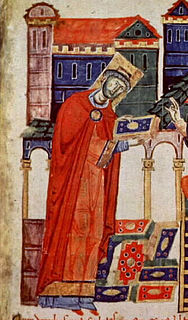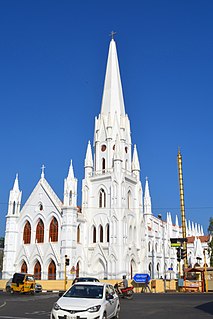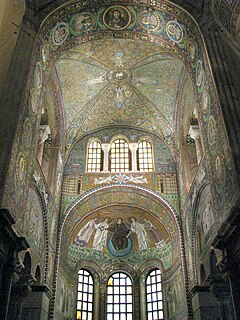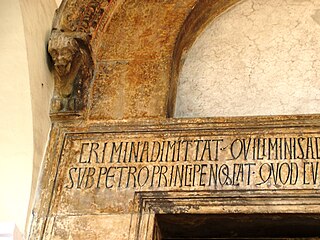
Pope Victor III, born Dauferio, was the head of the Catholic Church and ruler of the Papal States from 24 May 1086 to his death. He was the successor of Pope Gregory VII, yet his pontificate is far less notable than his time as Desiderius, the great abbot of Montecassino.

Monte Cassino is a rocky hill about 130 kilometres (80 mi) southeast of Rome, in the Latin Valley, Italy, 2 kilometres west of Cassino and at an elevation of 520 m (1,710 ft). Site of the Roman town of Casinum, it is widely known for its abbey, the first house of the Benedictine Order, having been established by Benedict of Nursia himself around 529. It was for the community of Monte Cassino that the Rule of Saint Benedict was composed.

A mosaic is a pattern or image made of small regular or irregular pieces of colored stone, glass or ceramic, held in place by plaster/mortar, and covering a surface. Mosaics are often used as floor and wall decoration, and were particularly popular in the Ancient Roman world.

The architecture of cathedrals and great churches is characterised by the buildings' large scale and follows one of several branching traditions of form, function and style that derive ultimately from the Early Christian architectural traditions established in Late Antiquity during the Christianization of the Roman Empire.
Sant'Angelo is an Italian name for the Archangel Michael.

The medieval art of the Western world covers a vast scope of time and place, over 1000 years of art in Europe, and at certain periods in Western Asia and Northern Africa. It includes major art movements and periods, national and regional art, genres, revivals, the artists' crafts, and the artists themselves.

The Sanctuary of Saint Michael the Archangel is a Roman Catholic shrine on Mount Gargano, Italy, part of the commune of Monte Sant'Angelo, in the province of Foggia, northern Apulia. It has the dignity of a minor basilica.

Cassino is a comune in the province of Frosinone, Central Italy, at the southern end of the region of Lazio, the last city of the Latin Valley.

Monte Sant'Angelo is a town and comune of Apulia, southern Italy, in the province of Foggia, on the southern slopes of Monte Gargano.

Nilus the Younger, also called Neilos of Rossano was a monk, abbot, and founder of Italo-Byzantine monasticism in southern Italy. He is venerated as a saint in the Eastern Orthodox and Roman Catholic churches, and his feast day is celebrated on September 26 in both the Byzantine Calendar and the Roman Martyrology.

Jordan II was the third son of Prince Jordan I of Capua and Princess Gaitelgrima, a daughter of Prince Guaimar IV of Salerno. He was, from at least May 1109, the lord of Nocera, and, after June 1120, Prince of Capua. The date and place of his birth are unknown, but it must have been later than 1080. He was married, before 1113, to Gaitelgrima, daughter of Sergius, Prince of Sorrento, a union which allowed him to extend his influence down the Amalfi coast from his castle at Nocera.

San Biagio Saracinisco is a comune (municipality) in the Province of Frosinone in the Italian region of Lazio, located about 120 kilometres (75 mi) east of Rome and about 50 kilometres (31 mi) east of Frosinone.

Valle Latina is an Italian geographical and historical region that extends from south of Rome to Cassino, corresponding to the eastern area of ancient Roman Latium.
The decade of the 1100s in art involved some significant events.

Italy has the richest concentration of Late Antique and medieval mosaics in the world. Although the art style is especially associated with Byzantine art and many Italian mosaics were probably made by imported Greek-speaking artists and craftsmen, there are surprisingly few significant mosaics remaining in the core Byzantine territories. This is especially true before the Byzantine Iconoclasm of the 8th century.

Duecento is the Italian word for the Italian culture during the 13th century.

The Throne of Maximian is a cathedra that was made for Archbishop Maximianus of Ravenna and is now on display at the Archiepiscopal Museum, Ravenna. It is generally agreed that the throne was carved in the Greek East of the Byzantine Empire and shipped to Ravenna, but there has long been scholarly debate over whether it was made in Constantinople or Alexandria.

Robert was a south Italian nobleman who ruled the counties of Airola, Alife, Caiazzo, Sant'Agata and Telese from 1088 until his death. He was the regent of Capua in 1090–93, and was effectively independent of any lord after 1105. He was a major patron of churches and abbeys, and also commissioned several books.
Atenulf was the Abbot of Montecassino from 1011 until his death. He was a cousin of Prince Pandulf II of Capua, a younger son of Prince Pandulf III and brother of Prince Pandulf IV.

Madonna of Constantinople is a tempera painting created by Greek painter Angelos Pitzamanos. Angelo was from the island of Crete. He was active from 1482 to 1535. His teacher was famous painter Andreas Pavias. Angelo finished commissions with his brother Donatus Pitzamanos. Eleven remaining works are attributed to Angelo. He signed most of his works in Latin, his signature poem was Angelus Bizamanus the Greek painter from Crete.




















